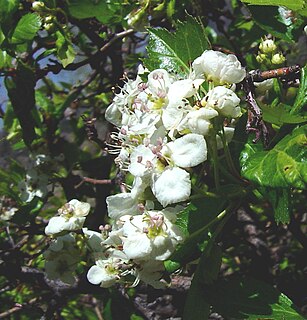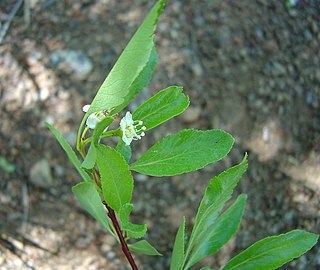
Crataegus, commonly called hawthorn, quickthorn, thornapple, May-tree, whitethorn, or hawberry, is a genus of several hundred species of shrubs and trees in the family Rosaceae, native to temperate regions of the Northern Hemisphere in Europe, Asia, North Africa, and North America. The name "hawthorn" was originally applied to the species native to northern Europe, especially the common hawthorn C. monogyna, and the unmodified name is often so used in Britain and Ireland. The name is now also applied to the entire genus and to the related Asian genus Rhaphiolepis.

Crataegus monogyna, known as common hawthorn, oneseed hawthorn, or single-seeded hawthorn, is a species of flowering plant in the rose family Rosaceae. It is native to Europe, northwest Africa and West Asia but has been introduced in many other parts of the world.

Crataegus laevigata, known as the midland hawthorn, English hawthorn, woodland hawthorn or mayflower, is a species of hawthorn native to western and central Europe, from Great Britain and Spain east to the Czech Republic and Hungary. It is also present in North Africa. The species name is sometimes spelt C. levigata, but the original orthography is C. lævigata.

Crataegus douglasii is a North American species of hawthorn known by the common names black hawthorn and Douglas' thornapple. It is named after David Douglas, who collected seed from the plant during his botanical explorations.
Crataegus altaica is a species of hawthorn. It is sometimes considered to be a synonym of C. wattiana. Crataegus altaica var. villosa is considered to be a synonym of Crataegus maximowiczii.

Crataegus ambigua is a species of thorn (hawthorn) native to Western Asia and Eastern Europe, including Armenia, Iran, Russia, and Turkey. It grows as a shrub or tree up to about 12 m in height. The fruit is dark red to purple or black, with one or two stones (pyrenes).

Crataegus azarolus is a species of hawthorn known by the common names azarole, azerole, and Mediterranean medlar. It is native to the Mediterranean Basin and is a common plant there, growing on sites comparable to those the European common hawthorn grows on. In the Arab countries it is the commonest of the hawthorn species. When growing in the wild the azerole bears plentiful crops of haw fruits, which are similar to the haws of the European common hawthorn, but plumper.
Crataegus brachyacantha is one of the "black-fruited" species of hawthorn, but it is only very distantly related to the other black-fruited species such as C. douglasii or C. nigra. The common names blueberry haw and blueberry hawthorn refer to the appearance of the fruit, which are almost blue, and does not refer to their taste. The species is rarely cultivated but has ornamental leaves, flowers, and foliage. It is native to Louisiana, and also occurs just across the border of neighbouring states.

Crataegus chrysocarpa is a species of hawthorn that is native to much of the continental United States and Canada. Common names fireberry hawthorn and goldenberry hawthorn, as well as the scientific name all refer to the colour of the unripe fruit, although the mature fruit is red and in var. vernonensis is "deep claret-colored … nearly black when over-ripe".
Crataegus × dsungarica is a hawthorn that is a hybrid between C. songarica in C. sect. Crataegus and C. wattiana in C. sect. Sanguineae. It has blackish purple fruit.

Crataegus erythropoda is a hawthorn native to the southern Rocky Mountains in the United States. The leaves are conspicuously shiny above and fruit ("haws") are dark purplish red. It is seldom cultivated, but at one time was listed in the nursery trade under the common name "Chocolate Haw". It is closely related to C. rivularis which has fruit that are fully black when ripe.
Crataegus nigra, the Hungarian thorn or Hungarian hawthorn, is a black-fruited species of hawthorn native to the western balkan and the Pannonian Basin, spanning from Slovakia to Albania. The fruit, which is up to 10 mm across, can be consumed fresh or cooked.

Crataegus pentagyna, also called small-flowered black hawthorn, is a species of hawthorn native to southeastern Europe. Two subspecies are recognized, C. p. subsp. pentagyna and C. p. subsp. pseudomelanocarpa. The fruit are usually black, but are sometimes a handsome purple.

Crataegus punctata is a species of hawthorn known by the common names dotted hawthorn or white haw that is native to most of the eastern United States and eastern Canada. While some sources claim it is the state flower of Missouri, the actual legislation does not identify an exact species. Furthermore, the Missouri Department of Conservation asserts the Crataegus mollis was specifically designated as the state flower.

Crataegus rivularis is a species of hawthorn known by the common name river hawthorn. It is native to the intermontane region of the northwestern United States, situated between the coastal ranges and the Rocky Mountains.

Crataegus saligna is a species of hawthorn known by the common name willow hawthorn that is seldom cultivated and rather rare in the wild. Its native range is wet areas of western Colorado and northeastern Utah. It is a handsome shrub or small tree with delicate-looking leaves, small flowers, small black fruit, and beautiful reddish bark.

Crataegus mexicana is a species of hawthorn known by the common names tejocote, manzanita, tejocotera and Mexican hawthorn. It is native to the mountains of Mexico and parts of Guatemala, and has been introduced in the Andes. The fruit of this species is one of the most useful among hawthorns.

Crataegus phippsii is a species of hawthorn native to south-central British Columbia, Washington state, and Montana. It forms a shrub or small tree to 7 m in height with leaves that have white hair on the underside, and fruit that ripen through red to purplish black. It appears to have potential as an ornamental plant.
Crataegus songarica is an Asian species of hawthorn with black fruit that is sometimes used medicinally. It is closely related to Crataegus ambigua, a species that has red fruit.














